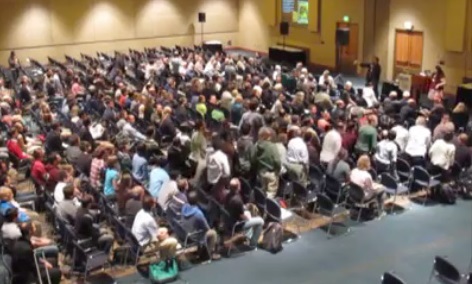On the fourth day of the 2015 SIAM Dynamical Systems Conference at Snowbird, UT, following Professor Jeff Gore’s talk “Cooperation, Cheating and Collapse in Biological Populations,” about 200 attendees lined up to form a square lattice and perform a living simulation. They were instructed to follow the dynamics of an excitable system where all participants
-
start by sitting down,
-
stand up if any of their four nearest neighbors stood up,
-
stay standing for 3 seconds (activation), and then
-
sit back down (deactivation).
To initialize the “simulation,” we gave an initial condition of a broken wave; that is, the front half of the middle column of the grid was asked to stand. Those to the right of this column were told to stay in deactivation just for the first time while those to the left were told to follow rule 2. and begin activation.
The result: a spiral wave. Or rather, in this case, chaos!
Background
I am a graduate student working in the Complex Heart Arrhythmias and Oscillating Systems (CHAOS) lab under the direction of Prof. Flavio Fenton in the School of Physics at Georgia Institute of Technology. As part of this research group, I study synchronization and coherence in biological systems as well as spiral wave formation within cardiac and other systems. Besides cardiac systems [1-2], spiral waves form in many other natural systems such as galaxy structure [3], crystal growth [4] and more [5]. Prof. Fenton was inspired by the human wave that is commonly seen at sporting events to further investigate spiral wave formation and breakup in a fun and interactive way.

Human spiral wave at DS15 directed by Andrea Welsh and Flavio Fenton and filmed by Ilija Uzelac.
As part of this large-scale event, Prof. Fenton and I, along with Dr. Ilija Uzelac filming from a balcony above the participants, arranged the 200 constrained volunteers to position themselves in a grid using the chairs they were sitting in.
Upon following our instructions, a spiral wave propagated in a clockwise direction. In general, depending on the size of the system and the time it takes for individuals to reset their positions, the wavelength of the spiral may change so that more than one arm may be seen from overhead. Other factors that affect the dynamics include the human tendency to anticipate the coming wave and activate earlier than is intended, as well as individuals failing to respond to appropriate visual cues provided by their nearest neighbors. A combination of these two cause the spiral wave to break up into chaos. While the CHAOS lab had attempted this event twice along with graduate student Jairo Rodriguez and Dr. Edwin Greco with Georgia Tech students and faculty (approximately 500-600) as part of the annual Atlanta Science Festival, we also thought it would be a fun experiment to attempt with others interested in dynamical systems.
At Snowbird, Prof. Fenton and I attempted this activity at the end of the Wednesday morning session. Because this was towards the end of the conference and because there was a rush to get to lunch, there were not as many participants as we had hoped. There was also a break in our human lattice from the lack of seats in the aisles which divided up the audience. Nevertheless, we were able to see the start of a spiral forming before the dynamics quickly broke into chaos. Part of this seemed to be from hesitant researchers not confident enough to stand up at the appropriate times (you know who you are). By the third attempt of the morning, as confidence and excitement had built among the attendees, the spiral seemed to have stabilized for a few rotations before the chaotic breakup into lunch.
The entire event can be seen in the video below; the voices belong to Prof. Fenton and myself. We hope to host this event again at SIAM DS17 with a bigger human lattice and excitement from more attendees!
[1] Ito H. and Glass L. Spiral breakup in a new model of discrete excitable media.
Phys. Rev. Lett. 1993; 66: 671-674.
[2] Cherry E.M. and Fenton F.H. Visualization of spiral and scroll waves in simulated and experimental cardiac tissue.
New J. Phys. 2008; 10: 125016.
[3] Lin C.C. On the mathematical theory of galaxy of stars.
SIAM J. Appl. Math. 1966; 14: 876–921.
[4] Smereka P. Spiral crystal growth.
Physica D 2000; 138: 282–301.
[5] Bini D., et al. On spiral waves arising in natural systems.
Commun. Comput. Phys. 2010; 8: 610-622.